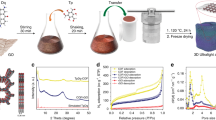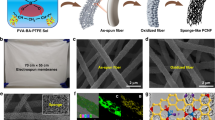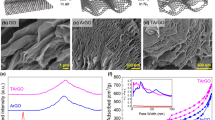Abstract
Graphene-based conductive porous materials have been employed in various applications, such as sensors, energy devices, and magnetic shielding materials. Herein, we prepared porous cellulose nanofiber (CNF)/graphene composites with a two-step preparation strategy: fabrication of the porous CNF/graphene oxide (GO) precursors and postreduction of the GO to reduced GO (rGO). The porous precursors were prepared via freeze-drying to obtain honeycomb-like pore structures, and the GO was highly dispersed owing to its high affinity for CNFs. Thermal reduction of the CNF/GO precursor was performed at <150 °C for 48 h, resulting in a porous CNF/rGO composite with an electrical conductivity of 1.96 × 10−4 S/m at 10 wt% GO owing to the electrically conductive paths in the rGO. Furthermore, the mechanical properties of the porous composites were characterized via compressive stress measurements. In addition, we demonstrated another postreduction method, i.e., chemical vapor reduction of CNF/GO with trimethylamine borane, which was completed within 30 min and provided a porous CNF/rGO composite with excellent conductivity (1.39 × 10−3 S/m).
This is a preview of subscription content, access via your institution
Access options
Subscribe to this journal
Receive 12 print issues and online access
$259.00 per year
only $21.58 per issue
Buy this article
- Purchase on Springer Link
- Instant access to full article PDF
Prices may be subject to local taxes which are calculated during checkout







Similar content being viewed by others
References
Liu Z, Yuan X, Zhang S, Wang J, Huang Q, Yu N, et al. Three-dimensional ordered porous electrode materials for electrochemical energy storage. NPG Asia Mater. 2019;11:12.
Tao Y, Sui Z-Y, Han B-H. Advanced porous graphene materials: from in- plane pore generation to energy storage applications. J Mater Chem A. 2020;8:6125–43.
Ding Y, Xu T, Onyilagha O, Fong H, Zhu Z. Recent advances in flexible and wearable pressure sensors based on piezoresistive 3d monolithic conductive sponges. ACS Appl Mater Interfaces. 2019;11:6685–704.
Pai AR, Azeez NP, Thankan B, Gopakumar N, Jaroszewski M, Paoloni C, et al. Recent progress in electromagnetic interference shielding performance of porous polymer nanocomposites—a review. Energies. 2022;15:3901.
Irin F, Das S, Atore FO, Green MJ. Ultralow percolation threshold in aerogel and cryogel templated composites. Langmuir. 2013;29:11449–56.
Hu H, Zhao Z, Zhang R, Bin Y, Qiu J. Polymer casting of ultralight graphene aerogels for the production of conductive nanocomposites with low filling content. J Mater Chem A. 2014;2:3756–60.
Wang Z, Shen X, Han NM, Liu X, Wu Y, Ye W, et al. Ultralow electrical percolation in graphene aerogel/epoxy composites. Chem Mater. 2016;28:6731–41.
Han NM, Wang Z, Shen X, Wu Y, Liu X, Zheng Q, et al. Graphene size-dependent multifunctional properties of unidirectional graphene aerogel/epoxy nanocomposites. ACS Appl Mater Interfaces. 2018;10:6580–92.
Sun Z, Fang S, Hu YH. 3D graphene materials: from understanding to design and synthesis control. Chem Rev. 2020;120:10336–453.
Guan L-Z, Zhao L, Wan Y-J, Tang L-C. Three-dimensional graphene-based polymer nanocomposites: preparation, properties and applications. Nanoscale. 2018;10:14788–811.
Li Y, Samad YA, Polychronopoulou K, Alhassan SM, Liao K. Highly electrically conductive nanocomposites based on polymer-infused graphene sponges. Sci Rep. 2014;4:4652.
Parviz D, Shah SA, Odom MGB, Sun W, Lutkenhaus JL, Green MJ. Tailored network formation in graphene oxide gels. Langmuir. 2018;34:8550–9.
Shen X, Wang Z, Wu Y, Liu X, He Y-B, Zheng Q, et al. A three-dimensional multilayer graphene web for polymer nanocomposites with exceptional transport properties and fracture resistance. Mater Horiz. 2018;5:275–84.
Liu Z, Shen D, Yu J, Dai W, Li C, Du S, et al. Exceptionally high thermal and electrical conductivity of three-dimensional graphene-foam-based polymer composites. RSC Adv. 2016;6:22364–9.
Wang M, Duan X, Xu Y, Duan X. Functional three-dimensional graphene/polymer composites. ACS Nano. 2016;10:7231–47.
Qin Y, Peng Q, Ding Y, Lin Z, Wang C, Li Y, et al. Lightweight, superelastic, and mechanically flexible graphene/polyimide nanocomposite foam for strain sensor application. ACS Nano. 2015;9:8933–41.
Sun R, Chen H, Li Q, Song Q, Zhang X. Spontaneous assembly of strong and conductive graphene/polypyrrole hybrid aerogels for energy storage. Nanoscale. 2014;6:12912–20.
Isogai A. Cellulose nanofibers: recent progress and future prospects. J Fiber Sci Technol. 2020;76:310–26.
Hosseini H, Kokabi M, Mousaavi SM. BC/rGO conductive nanocomposite aerogel as a strain sensor. Polymer. 2018;137:82–96.
Chen Y, Pötschke P, Pionteck J, Voit B, Qi H. Multifunctional cellulose/rGO/Fe3O4 composite aerogels for electromagnetic interference shielding. ACS Appl Mater Interfaces. 2020;12:22088–98.
Singh RK, Kumr R, Singh DP. Graphene oxide: strategies for synthesis, reduction and frontier applications. RSC Adv. 2016;6:64993–5011.
Wang X, Zhi L, Müllen K. Transparent, conductive graphene electrodes for dye-sensitized solar cells. Nano Lett. 2008;8:323–7.
Marcano DC, Kosynkin DV, Berlin JM, Sinitskii A, Sun Z, Slesarev A, et al. Improved synthesis of graphene oxide. ACS Nano. 2010;4:4806–14.
Tu C, Nagata K, Yan S. Dependence o electrical conductivity on phase morphology for graphene selectively located at the nterface of polypropylene/polyethylene composites. Nanomater. 2022;12:509–20.
Pan Z-Z, Nishihara H, Iwamura S, Sekiguchi T, Sato A, Isogai A, et al. Cellulose nanofiber as a distinct structure- directing agent for xylem-like microhoneycomb monoliths by unidirectional freeze-drying. ACS Nano. 2016;10:10689–97.
Chen Y, Yang S, Fan D, Li G, Wang S. Dual-enhanced hydrophobic and mechanical properties of long- range 3d anisotropic binary-composite nanocellulose foams via bidirectional gradient freezing. ACS Sustain Chem Eng. 2019;7:12878–86.
Lipatov A, Guinel MJ-F, Muratov DS, Vanyushin VO, Wilson PM, Kolmakov A, et al. Low-temperature thermal reduction of graphene oxide: in situ correlative structural, thermal desorption, and electrical transport measurements. Appl Phys Lett. 2018;122:053103.
Morimoto N, Kubo T, Nishina Y. Tailoring the oxygen content of graphite and reduced graphene oxide for specific applications. Sci Rep. 2016;6:21715.
Chen J, Li H, Zhang L, Du C, Fang T, Hu J. Direct reduction of graphene oxide/nanofibrillated cellulose composite film and its electrical conductivity research. Sci Rep. 2020;10:3124.
Chua CK, Pumera M. Reduction of graphene oxide with substituted borohydrides. J Mater Chem A. 2013;1:1892.
Pham VH, Hur SH, Kim EJ, Kim BS, Chung JS. Highly efficient reduction of graphene oxide using ammonia borane. Chem Commun. 2013;49:6665–7.
Takashima Y, Sato Y, Tsuruoka T, Akamatsu K. Controlled syntheses of Ag nanoparticles inside MOFs by using amine–borans as vapour phase reductants. Dalton Trans. 2020;49:17169–72.
Martins TB, Miwa RH, Silva AJR, Fazzio A. Electronic and transport properties of boron-doped graphene nanoribbons. Phys Rev Lett. 2007;98:196803–7.
Acknowledgements
This work was supported by the Tatematsu Foundation and JSPS KAKENHI Grant-in-Aid for Early-Career Scientists (23K13558). The FESEM and TEM observations and XPS measurements were performed at the Equipment Sharing Division, Organization for Co-Creation Research and Social Contributions, Nagoya Institute of Technology. The authors thank Dr. Yoko Sakurai for performing FESEM observations, Ms. Atsuko Mori for performing TEM observations, and Mr. Yukihisa Moriguchi and Ms. Yoko Yamazaki for performing XPS measurements.
Author information
Authors and Affiliations
Corresponding author
Ethics declarations
Conflict of interest
The authors declare no competing interests.
Additional information
Publisher’s note Springer Nature remains neutral with regard to jurisdictional claims in published maps and institutional affiliations.
Supplementary information
Rights and permissions
Springer Nature or its licensor (e.g. a society or other partner) holds exclusive rights to this article under a publishing agreement with the author(s) or other rightsholder(s); author self-archiving of the accepted manuscript version of this article is solely governed by the terms of such publishing agreement and applicable law.
About this article
Cite this article
Eguchi, H., Hayashi, H. & Nagata, K. Electrical conductivities and mechanical properties of porous cellulose nanofiber/reduced graphene oxide composites prepared with postreduction processes. Polym J 56, 185–192 (2024). https://doi.org/10.1038/s41428-023-00861-x
Received:
Revised:
Accepted:
Published:
Issue Date:
DOI: https://doi.org/10.1038/s41428-023-00861-x



